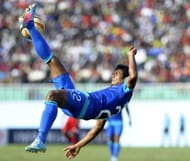For the world, there’s not much to talk about India and her footballing credentials. In fact, the very existence of the game in the peninsula might well be unheard of, among a vast majority of the football following population.
Yet a century ago, football had engraved an ever-lasting mark into the history of Indian nationalism. In 1911, when the cries of “Swaraj” (self-rule) was gathering momentum across the nation, Calcutta based club team Mohun Bagan took to the field against a vastly superior East Yorkshire regiment in the final of the prestigious IFA Shield.
However, with odds staked highly against them, the eleven barefoot men would go on to do the unthinkable; as the Britishers succumbed in front of a 80,000 strong hostile crowd; losing 2-1 to the overwhelming underdogs.
It was a pivotal point in Indian history as for once the nation had found a source of self esteem – a belief that they can outsmart and outdo their rulers in an even playing field. According to a somewhat forgotten urban legend, it is said as the British players scampered away from the city in embarrassment, a Hindu priest among the delighted home crowd, pointed at the Union Jack atop the Fort William and asked “When will that come down?” – to which someone replied – “It’l come down when we win the shield again.”
Incidentally, Mohun Bagan lifted their next IFA Shield in 1947 – the year of India’s independence!
Fast-forward exactly 102 years – and to now say that Indian football has remained more or less static since that fateful day in 1911, would be a rather clever use of euphemism. For almost half a century, the country’s footballing glory was merely confined to a “golden generation” that lasted from the mid-50s to the early 60s – a side that briefly reigned as the kings of Asia and came tantalizingly close to a Olympic medal in 1956.
And when Cricket finally announced its grand arrival into the Indian sporting scene in 1983, as Kapil Dev‘s underdog team lifted the World Cup in the historic ground of Lord’s, the country had already found their new fascination – football by then, was slipping into absolute obscurity!
Currently languishing at the bottom half of the FIFA rankings (155 to be precise), the country has failed to live up to the promise it once made. So, where did we go wrong? And is there perhaps a way of resurrection? Well, a systematic look into the country’s footballing structure could probably give us an insight.
With a history of over a century, India’s footballing infrastructure is almost surprisingly somewhere between primitive and non-existent. The national league structure was established sixteen years ago and while a rechristening in the year of 2007 saw the foundation of a professional league – the I-League – raising substantial hope across the country, very little has changed in practicality.
With no concrete planning and identification of revenue streams, the clubs and academies are vastly dependent on donors and benefactors. The state of investments from within the country and abroad is deplorable, especially given the ever-sliding rupee.
In any case, the league has attracted very little eyeballs – with empty stands a frequent feature in league games. This lack of popularity almost in a way puts the final nail in the coffin, when it comes to investments – you really wouldn’t bet on any sort of returns in a scenario such as this.
In fact, so poor has been the infrastructural situation, that early last month, all 14 I-League clubs failed to fulfill the licensing criterion – a mandate given by the Asian Football Federation(AFC) and approved by the All India Football Federation(AIFF).The cash flow in the AIFF is also understandably not the most the ideal either.
However, in the midst of all this, enters a proposal of a franchise based tournament from the marketing and commercial partners of the AIFF, IMG Reliance – somewhere in the lines of the highly successful and cash rich brainchild of Indian cricket – the Indian Premier League.
The franchise based tournament promises marquee imports from abroad, celebrity owned teams, packed stadiums under floodlight and inter-province rivalry – in short, everything that Indian football craves for right now. The fact that players will actually be “auctioned” has been somewhat judged fascinating among some sectors of the international media – who are not quite accustomed to such a concept in football.
Meanwhile, however, there has been rise of a certain school of thought, especially among the top offices of the I-League clubs, who are not quite sure about the credentials of such a footballing model and are not entirely convinced by the impact it can have on the I-League and Indian football.
The AIFF, seeking an amicable solution, have given a green signal for the tournament, but it’s future might well have not yet been settled.
The popularity of football in India is at an all time high. In a survey conducted by Celebrity Management Group in 2011, it was revealed while there has been as many as 176 million viewers for cricket in India at the latter part of the last decade, the figures for football has almost touched their cricket counter-part at 155 million.
But now, here lies the fallacy. The past decade has seen an highly aggressive marketing of European football and with extensive broadcast of various foreign leagues, there has been a massive rise in football fans among the Indian urban population, who have pledged their loyalties towards various European clubs – making their brand of football, a highly followed and researched one at this part of the world.
However, the interest towards the indigenous brand has remained limited – which is understandable given the unplanned “hoof-ball” nature of play here – hardly serving the aesthetic point of view.
In addition, the clubs have done virtually nothing to reach out to the fans. The Kolkata derby between traditional arch rivals Mohun Bagan and East Bengal sees attendances that swells up to 100,000 – even bigger than the El Clasico or the Manchester Derby – but that is just about the only game that actually reminds you of what could have been of Indian football.
Lack of official fan clubs, supporters’ trust, non-existent platform for official merchandises, no season ticketing, official club channels being a mere myth and various other factors have contributed to the sheer negligence of the clubs towards their fans. The emergence of North East representation in the I-League has somewhat been a saving grace – with the clubs showing consistent attendance records from the fans.
The football minority have looked on in skepticism as the cricketing body flourished in the country both financially and in terms of results. Cricket’s exponential rise over the years have often been seen as “fishy” and with the game being recently marred by off-field controversies involving match fixing and betting, the outsiders feel that the cricket body’s “unlawful” activities have been the primary reason for the money that is now there in cricket.
And as outrageous as it may sound, a vast majority of the “non-cricket” community deem cricket responsible for the downfall of football as well as other sports in India. However, despite being a staunch football advocate, such a school of thought, in my opinion, is nothing but a case of ‘sour grapes’.
It is imperative to understand, for a product to be so successful, it can’t be solely run in a corrupt way for all these years. Obviously, there has to be a lot of “good’ people doing a lot of good work, from the grass-root level to the apex, that has made cricket what it is today in the country.
Yes again, a product as big as Indian cricket, will also at times attract some very ordinary people or rather creepers who will try to reap undue benefits of what is a highly flourishing model – but that is just a part of the package and turning a blind eye towards all the good lessons that can be taken from cricket’s incredible rise, because of that, is rather delusional.
The cricket body had been incredibly proactive in marketing the game, when they were backed by the results, turning the game into a national obsession. Such proactive-ness from the part of football, or perhaps any other game, has been somewhat missing and while there has been patches of good periods in terms of results, no one has really been able to cash on to it – Good things have easily been forgotten!
With a population of over 1.2 billion; with people originating out of various races; hailing from innumerable landscapes and cultures, it would be impossible to believe that the country wouldn’t be able to produce a squad of football players who would be “genetically” capable of playing the game at the highest level. There always has been the potential but the potential has to blossom – that is where lies the country’s biggest stumbling block.
The footballing market in India again remains “potentially” lucrative – although vastly unexploited. The rising popularity of European football in India has meant the game in general has already revived its fan base, unlike many other sports. Now, with this existing fan base at disposal, it is now a matter of merely diversifying or rather making them share their attentions towards the Indian brand as well.
In a way, the injection of European football in India has somewhat been a “necessary evil” – which has created a breeding ground for football to flourish, both in terms of popularity and the financial point of view.
Various European clubs, much like in other Asian countries, have also turned their eyes towards the shores of India in the recent years – most notably the likes of Barcelona, Bayern Munich, Manchester United, Blackburn Rovers, Liverpool and Chelsea – lending their hand in various developmental projects and while most of these activities are often mere marketing gimmicks than anything, it only points to the fact that India’s footballing market is slowly but steadily catching the attentions from abroad. Such tie-ups and investments can only lead to a “dual-party” benefit – one half of the dual party being, of course Indian football.
Returning to the franchise based tournament, it indeed has some gaping loopholes. While it provides the much needed commercialization of the game in India, it’s advent, may jeopardize the I-League; it may also lead to unwanted off-field troubles, as was quite evident in the cricket’s counterpart.
But, it is about time that something has to give in Indian football. The league structure is at an all time low, and what is important is the evaluation of how much harm can the franchise based side-tournament do compared to the good. At this point of time, however, it is quite difficult to imagine what exactly there IS to lose in Indian football!
In United States, the 1994 World Cup changed the face of football in the country, and although hosting something like a World Cup is a distant dream for India, considering the financial and infrastructural deficiencies, who knows, maybe, just maybe a marquee tournament such as this, might well be a shot in the arm for Indian football.
Perhaps, with franchises aiming ruthlessly at success, their big investments could indirectly lead to more exposure for local players, improvement in the academies and reconstruction of stadium facilities. After all, we would never know, until we explore, explore the unknown!




